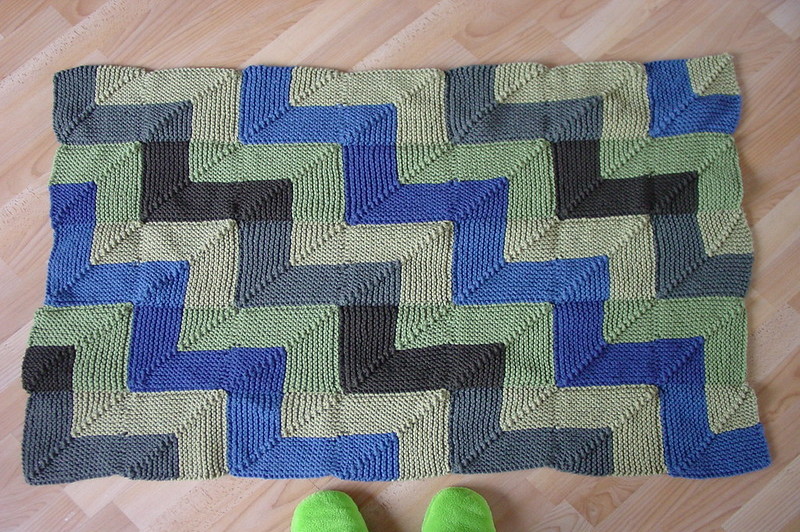Here, we will tackle three ways on how to knit a zig zag blanket. Winter is a popular time to make blankets of different patterns, which you wouldn’t want to miss.
Knitting zig zag blankets are like knitting stripes with top points and bottom points. They may look complicated at first glance, but they’re not! Zigzag patterns appear on your blanket once you repeat pairs of increases and decreases at regular intervals.

Three Ways To Knit A Zig Zag Pattern
Method #1. Make zig zags
First, plan how many stitches you need to work on and start with a product of six. It can ensure a regular pattern on your blanket. For example, if you like to begin with 40 stitches, choose 36 because it’s a product of six.
It’s also best to keep in mind that the wideness of your fabric can vary based on the number of stitches you’re going to work on. Few stitches can lead to a narrow pattern, while more stitches can widen it.
Casting the right amount of stitches must be well-thought. Careful planning can take care of tight casting.
You will need to know how to do a rib stitch and modify it for most of this process. Knitting and purling require different kinds of formulas, which can confuse most of us.
Moreover, you might want help getting over the first eight rows here. The article may include many terms that might confuse beginners, but practice always leads to perfection.
Work on and repeat the process until the end of the blanket
Method #2. Create chevron pattern
A Chevron pattern is a reversed V connected on each end. It results in a zigzag on the finished product.
Cast a product of twelve on the start and add three stitches. Purl the stitch on every odd-numbered row. After this, work and stack the decreasing and increasing rows alternatively.
Repeat this process until the blanket reaches your desired length. After that, it is time to cast off the chevron stitch.
Method #3. Combine the chevron and zig zag pattern
You still can’t decide what method you’re going to use for your zig zag blanket? Good news for you because you can use both! This method is also the most advisable one to create a large fabric like blankets.
On the other hand, it also suggests knowledge on the two methods discussed previously. Once you’ve known it, you can incorporate and use your favorite colors to knit your blanket.
How Many Stitches Do I Cast On For A Blanket?
Many articles and knitting tutorials sometimes provide how many stitches you need to cast on a particular fabric. These can cause an added relief and confusion for many people. The truth is: the number of stitches depends on the final width you’ll prefer on the blanket you’re making.
If you’re planning to make a wide blanket, casting a large amount could be intimidating. In a world full of distractions, you can quickly lose count on the number of stitches you need to cast.
An easy way to measure is to wrap yarn as many as you can count on your needle, then unwrap this. Use this unwrapped yarn to calculate and estimate the amount that you need. It’s essential to leave an additional thread as a margin of error.
The number of stitches to cast depends on the pattern you want to use for the fabric. It also dictates the multiple of a number that you would be using. If a multiple is needed, you need to increase the number of stitches instead of subtracting.
Casting stitches is an important technique to know to minimize costs and bring out the best on the blanket you’re perfectly doing!
What Knitting Needles Do I Need For A Blanket?
Of course, you wouldn’t want a faulty needle while working on your blanket. You would need one that makes knitting convenient and comfortable for your hands. It is one of the primary tools you will need.
Circular needles are the best ones to use in knitting a blanket. These are long needles connected with a cord that carries the blanket’s weight. Using circular needles can prevent strain and fatigue on the wrists or hands.
Here are other factors that can help you out:
Needle size
The needle size should be appropriate for the yarn type you’re going to use. Finer yarns would only require a smaller needle, and you will need thicker needles on chunky yarns. Most of the time, you won’t need to worry about any of these because yarn packages indicate a needle size.
Straight needles
For the sake of beginners, other kinds of needles can be puzzling. Straight needles, as commonly known, can handle knitting blankets. You only have to make sure that they can accommodate the blanket’s width.
How Many Balls Of Yarns Do I Need For A Blanket?
Approximately, a zig zag blanket would need 18 – 30 balls of yarns. Although this can vary, keeping track of the amount of yarn you’re going to use is a strategic way. It could also help you save financially.
Conclusion
Learning how to knit a zig zag blanket gives you a whole new sense of recreation. You can also sell these blankets or use them for aesthetic pleasures.
Zig zag patterns only look complicated but are relatively easy to do. You only need to keep what you’re doing to make striped patterns and add increasing and decreasing intervals on them. If you’re having trouble, you can always go back to this article and read on.
